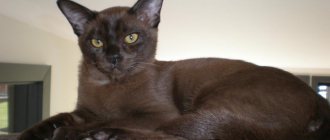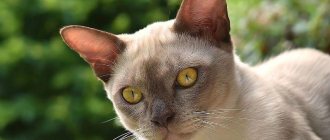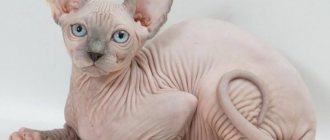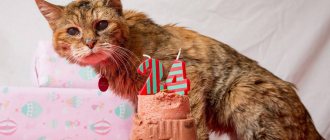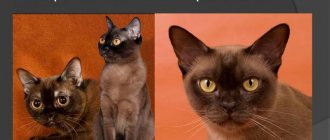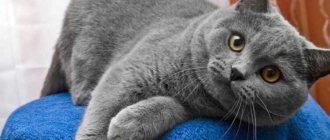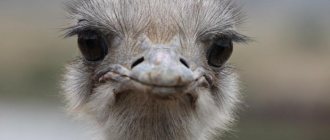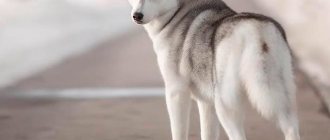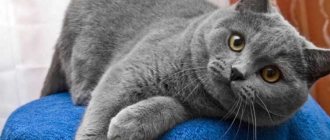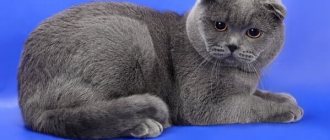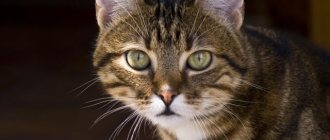Burmese cats are considered not only beautiful and elegant, but also have extraordinary thinking. Such a pet will become a real decoration of the house and the pride of the owners. They are original and intelligent, their short hair is always distinguished by original shades, and their large eyes are simply mesmerizing.
Experts distinguish several branches - American, Australian, European and Asian. They all differ from each other in shades, habits and some other features. Experts note that thanks to its appearance and independence, the Burmese will become a real home guard and the pride of the family.
History of the Burmese breed
The union of Burmese cats with people dates back to the times when representatives of this breed were considered sacred in their homeland. The homeland of Burmese cats is Burma (modern Myanmar), where the graceful animals were considered temples and were revered on a par with deities. According to legends, cats accompanied people during their transition to the kingdom of the dead. Keeping a cat in the house promised the owner prosperity and good luck.
The first Burmese were brought to San Francisco by Joseph K. Thompson in 1930. There were two of them: a male and a female, but the cat did not live very long, but the cat named Wong Mau was left alone and was included in the breeding program, the developers of which were Joseph K. Thompson, Billy Gerst, Virginia Cobb, as well as geneticist Clyde Keeler . The first mating was carried out with a Siamese cat Tai Mau, the second - with a brown kitten from the first litter. The babies of the third type were born and became the first representatives of the breed, which received the name Burmese.
In the mid-30s of the last century, the breed was recognized by the American Cat Fanciers Association (CFA) with the only color possible at that time - brown. However, in 1947, the breed was recalled due to the dishonesty of breeders who bred Burmese with representatives of Siamese cats. A year later, the first Burmese cats appeared in Great Britain and were recognized within 4 years. And in 1957, brown cats again received official status in the CFA.
Today there are two branches of the Burmese breed: American and European. Even crossing these two branches with each other is prohibited.
American Burmese are different from European ones
The photographs clearly show the differences between the American and European Burmese cats.
Burmese fur has a deep color
Character and habits
The Burmese cat is an ideal choice for those who are looking for a kind, affectionate, cheerful and loyal animal. The Burmese is incredibly active; even older cats of this breed take great pleasure in chasing sunbeams and flies.
Representatives of the Burmese are often called “cats with the soul of a dog.” Because they simply love to spend time with their owner, to participate in every moment of his life. Therefore, do not be surprised that it will be difficult to drive such a cat off your lap; it will follow you everywhere, and at night it will crawl under the blanket to sleep closer to the person.
An interesting feature: Burmese cats love all family members absolutely equally, but cats choose only one, who will become her favorite. Also, representatives of this breed very sensitively sense the mood of the owner and adapt well to it.
Compatible with children and other pets
Burmese cats get along well and get along well with other animals, be it dogs or parrots.
They also have wonderful relationships with children. Adults can rest assured that representatives of this breed will not scratch or hiss at children; on the contrary, they will happily take part in their games.
Description of the Burmese breed
Burmese are so unique that it is almost impossible to confuse them with other breeds. They outwardly resemble graceful pumas, but at the same time they are distinguished by their amiable character and playful disposition, which persists into adulthood.
Appearance: coat color and thickness, eye color, anatomical features
Despite the differences in the appearance of the American and European Burmese, the main features of their appearance are similar.
The Burmese cat is of medium size, muscular body, very harmoniously built. The back is straight, smoothly turning into a fairly long neck and a well-developed chest. The legs are quite thin, proportionate to the body, the hind legs are slightly longer than the front ones. The tail is of medium length, slightly tapering to a rounded tip.
The head is round in shape with large, widely set ears, rounded at the ends. The eyes are large, almost round, the iris can have shades from amber to yellow.
The Burmese's coat is short, satiny-silky, has virtually no undercoat, and lies tightly to the body. Always has a deep color.
It cannot be confused with any other breed
Colors
For the American Burmese, only 4 colors are recognized:
- sable (dark brown);
- champagne (chocolate);
- blue (bluish-gray);
- platinum (pale blue tone with lilac-pink coating).
The European Burmese has many more recognized colors:
- brown (warm dark brown);
- blue (bluish-gray with a pewter sheen);
- chocolate (from caramel to milk chocolate color);
- lilac (light gray with a pinkish tint);
- red (warm orange);
- cream (pastel cream);
- brown tortoiseshell (has black and red spots);
- chocolate tortoiseshell (milk chocolate coat has cream spots);
- blue tortoiseshell (bluish-gray coat with cream and light blue spots);
- lilac tortoiseshell (purple coat with light cream spots).
In both types of Burmese cats, color is temperature dependent. It changes depending on the ambient temperature: the colder it is, the darker the muzzle, back, tips of the paws and tail become.
The main differences in the appearance of American and European Burmese cats
In addition to color, there are several other features that make American and European Burmese different from each other.
- Eyes. In the American Burmese they are large and round, as if surprised, while in the European Burmese the upper line of the eye is almost straight, with a slight slope towards the nose, because of which the animal’s gaze seems stern, as if from under its brows.
- Ears. The American Burmese's ears are smaller, they are set higher and the distance between them is narrower than that of the European Burmese. At the same time, the ears of the European Burmese continue the line of the cheeks and have a slight tilt forward.
- Head. The European Burmese has a slightly more elongated muzzle, similar to a blunt wedge, while the American Burmese has a more rounded head shape and a slightly flattened muzzle.
- Torso. American women are more rounded and heavier in appearance, while European women are more graceful and sophisticated in appearance.
- Limbs. As in the case of the body, the European Burmese's paws are long and thin, while the American representative's paws are denser and have a rounded shape.
Despite their different appearances, they have similar characters
Traditional and modern American Burmese
American Burmese, in turn, are divided into two more types: modern and traditional. During exhibitions they are rated the same, but they differ in appearance. In the modern type, the transition from the forehead to the nose is more pronounced, the muzzle itself is shorter and wider compared to the traditional type. In addition, the eyes of the modern Burmese are more convex, which gives the muzzle an almost doll-like expression.
Character traits
The main quality of the Burmese, which makes it such a popular breed, is its extraordinary devotion to its owner. It’s not for nothing that this animal is called a cat-dog. However, they also get along well with dogs. In fact, these graceful creatures love people very much, tolerate loneliness extremely poorly and almost never show aggression towards people. This is a companion cat, keenly interested in everything that happens in the house. She will always be where people are. Does not tolerate loneliness well; in the event of a long absence of its owners, it becomes very bored.
It's impossible not to fall in love with them
At the same time, Burmese cats are affectionate and playful, remain active until old age and will never refuse the opportunity to run after a toy. They are inquisitive, tirelessly exploring the surrounding space, quickly reacting to changes in the environment. A passing midge will definitely attract the attention of a Burmese, as will a rolled out ball and a sunbeam running along the wall.
The oriental fluffy beauty will become a companion in the child’s childhood games, will patiently endure the baby’s pranks and will hardly be able to afford to let out her claws even once.
A friend of mine got a Burmese cat long before her daughter was born. The young mother, quite naturally, was worried about how the cat, who was the only object of love in the family before the baby’s appearance, and her growing daughter would get along with each other. In fact, for the first couple of weeks, Cassie (that’s the cat’s name) watched the newborn from afar, gradually reducing the distance to the baby’s crib. When, at about three months of age, the baby burst into tears, and her mother left the room at that moment, Cassie went in search of the owner and very demandingly called her to the girl. But that wasn’t even surprising for me. The grown-up baby, quite expectedly, wanted to constantly touch the cat. She crawled after her pet with amazing speed and periodically grabbed her by the tail, then by the paw. Cassie patiently endured all the squeezing, which was not always gentle, and never scratched the child. If the girl’s attention became too intrusive, Cassie simply left: she jumped on the closet or hid in the back room. Now the baby is five years old, and Cassie is already seven and it seems they have become just friends. When a girl comes with one of her parents after kindergarten, the cat certainly goes out into the corridor to meet them, but first she rubs herself against the child’s legs and purrs something joyfully in her cat language. And watching them play together is a real pleasure.
The Burmese cat is a reliable and loyal friend
Burmese get along well with other animals in the house; they will never be the first to show aggression, but if necessary, they can stand up for themselves. At the same time, the Burmese cat always occupies a leading position.
Burmese are well trained, easily assimilate the requirements of the owner, quickly understand where to sharpen, when and in what place to relieve their needs.
American and European Burmese type
The Burmese cat breed is divided into 2 varieties: European and American type. The American type looks more exotic - it is distinguished by a rounded, flattened muzzle, thick skin and dense hair. The American Burmese cat has expressive round eyes. They create a special expression on the face.
The European Burmese cat has an elongated muzzle - the head tends to take the shape of a rounded wedge. The European type of cat differs in the description of its fur; it does not have such gloss and shine. The skin is thinner. The American Burmese cat will always be heavier than the European one. In general, Europeans are more similar to the British.
Purchasing a Burmese kitten
When deciding to purchase a Burmese cat kitten, you need to understand that this must be a conscious and balanced choice. It is not recommended to purchase a Burmese kitten from someone else. If a potential owner wants to get a purebred kitten, then it must be purchased exclusively from a nursery. Only in this case can you purchase a healthy purebred kitten that can meet all the owner’s expectations.
Criterias of choice
When choosing a kitten, do not hesitate to ask the breeder about the character, nuances of keeping and the peculiarities of caring for the cat. You should also tell the seller about your expectations and goals. Usually, owners of trusted catteries are happy to select a kitten in accordance with the wishes of the potential owner.
- The baby should be active, playful and mobile.
- The kitten's fur is silky and shiny. Spots and medallions, as well as numerous white hairs in the color, are unacceptable. There may be faint stripes that disappear after six months. Over time, the baby's fur will acquire a darker shade.
- Ears, eyes, nose are clean.
At what age should you buy a kitten?
It is best to purchase kittens older than three months, since at this age the baby can be weaned from its mother and has already received the necessary vaccinations.
Other purchase details
There is no need to pick up a kitten directly from the exhibition; it is better to visit the nursery and see the conditions in which the kittens are kept and the behavior of the babies in their familiar environment.
If you purchase a baby for subsequent participation in exhibitions, the breeder will select a show-class kitten, but if you just need an affectionate and loyal friend, then when choosing, you can be guided solely by personal sympathies.
Burmese kittens are very inquisitive
How to choose a kitten
A Burmese kitten can be separated from its mother no earlier than three months from the moment of birth. During this period, the baby is ready for separation both physically and psychologically. When choosing a kitten from a nursery, you need to pay attention to its health. The kitten may have discharge from the eyes if they are clear in color. This is a regular tear fluid that cleanses the mucous membranes. You should be wary if it is yellow, in this case it is better to seek help from a veterinarian. Coat color develops before the first year. Sable color can be beige, with various shades of this color.
Purebred purebred animals can only be found in specialized nurseries. The bird market or ad sites are not the places where you can buy a real Burman. There is a high risk of acquiring a mestizo or a sick individual.
Kittens of the Burmese breed.
Who is the Burmese cat suitable for?
The Burmese breed is considered a versatile breed. Such pets take root well in all conditions if the family has children or other animals. Homebodies who will spend a lot of time with their pet can teach him simple tricks. You can walk with such a cat outside (just not during the frosty period). Allergy sufferers should not worry about animal hair; it does not provoke reactions.
If a person spends a lot of his time at work, it will be difficult for a cat, since they are considered sociable animals that need company and human attention. Being alone causes depression and stress.
How much does a Burmese cat cost?
You can buy a Burmese at a price from 15,000 to 35,000 rubles. The cost depends on the specific nursery, the pedigree of the animal, and its characteristics. If a kitten is purchased abroad, prices can vary from 30,000 to 50,000 rubles. Pet stores may offer lower prices, but it is more difficult to purchase a purebred purebred kitten here.
In the nursery you can choose ordinary Burmese or elite kittens. You can purchase disqualified kittens that have some flaws at a big discount. Individuals removed from breeding are also sold for a nominal fee.
Photo gallery: Burmese cat
These cats are incredibly beautiful
They don't like loneliness
Burmese are sociable, but unobtrusive
Get along well with other pets
Burma is a caring mother
The curiosity of cats of this breed knows no bounds.
Photo and video
Photos of adults and kittens:
Video:
Video: Burmese cat 101kote.Ru burmese 101cats
Video: Burmese cat all about the breed. Interesting Facts
Video: Burmese kitten - features of education
The Burmese shorthair cat is a wonderful pet. These are very sociable, kind and playful creatures that do not require careful care. Be sure to leave personal reviews if you have ever had contact with a Burmese, or you are the owner of one.
Keeping a pet
Keeping Burmese cats is not difficult, but requires knowledge of some features.
Nutrition
The quality of Burmese wool directly depends on the quality of food
The Burmese cat is not particularly picky about food, but the owner needs to know that it plays an important role in maintaining the health and activity of the cat, and also directly affects the lifespan of the graceful pet.
Quantity and composition of food
It is possible to provide food for a Burmese cat with both natural food and ready-made dry or canned food of high quality, that is, super premium class.
When feeding ready-made dry food, you should strictly follow the instructions on the packaging, measuring the recommended amount of food using a scale.
If the owner prefers to use canned food, usually one jar (80–100 grams) contains one serving of food.
Breeders and experienced Burmese owners recommend the following food for this breed:
- Pro Plan;
- Hill's;
- Eukanuba;
- Bozita;
- Nutro Choice;
- Iams;
- Innova Evo.
Quality cat food
Natural nutrition requires more time for preparation, variety in the diet and additional vitamin supplements. The basis of the diet is necessarily raw dietary meat, served to the pet after freezing and subsequent scalding with boiling water. A cat consumes 80–100 grams of meat per day, this is 80% of the total amount of food for the day. Dietary types of meat include white poultry meat, rabbit meat, beef and veal, as well as offal of these same animals. It is possible to include exclusively sea fish in the diet and no more than once a week.
You need to give your pet fermented milk products, hard-boiled egg yolk (no more than 2 pieces per week), fresh vegetables and herbs. These products make up the remaining 20% of the total food, their total weight can be about 20 grams.
There should always be a sufficient amount of clean drinking water available to the animal.
How many times a day should you feed your pet?
An adult cat is usually fed twice a day; no additional feeding is required. If the animal has not eaten its portion within half an hour, the food is removed until the next meal. This is how the pet gets accustomed to the correct diet.
Kittens are usually fed at least four times a day until about sixteen weeks of age, then they are transferred to three meals a day, and by the age of one year the baby can already eat 2 times a day.
The role of a balanced diet in cat health
It must be remembered that diet directly affects the health and beauty of the cat. With a properly selected and balanced diet, the cat remains active, its fur shimmers beautifully. If the coat becomes dull (and in the Burmese this becomes noticeable quickly), then the diet should be reconsidered. You may need to consult a veterinarian and then select a different food or create a new diet.
Appearance care
Caring for a Burmese cat is not difficult, the main thing is to follow certain rules, then the beauty with oriental notes in her appearance will delight you with her beauty every day.
Brushing and bathing
The coat is short and close to the body and does not require special care. It is enough to comb your pet once a week using a special brush with small silicone spikes; twice a month you can comb it with a special comb for animals - a furminator with the smallest tooth size. During molting, increase the number of combings to 2-3 per week.
Burmese are bathed only when they become dirty or in preparation for an exhibition. Shampoos are used specifically designed for animals, with mink oil or cocoa butter.
High quality grooming for pets
Other beauty tips
Once every two weeks, the Burmese needs to cut its claws with special scissors, and the kitten must be accustomed to this procedure from an early age. You should also examine your pet’s ears once a week and, if necessary, clean them using special lotions or solutions.
If your cat's eyes are sour and it is not permanent, you can wipe the eyes with a decoction of chamomile or tea.
Buying the necessary things for a kitten
Before a Burmese kitten appears in the house, you need to prepare for its reception, purchase the necessary dishes for the baby (one bowl for food, the second for water), a tray where the baby will relieve his natural needs, toys and a scratching post.
Burmese cats are very active, and toys allow them to channel their energy in the right direction. All kinds of balls, balls with an elastic band, feathers on a stick, mice will be a success during games.
A scratching post for Burmese is a necessary accessory, as these cats love to scratch their claws. If your pet does not have a special place for this activity, she will designate it for herself, but the upholstered furniture will suffer greatly.
When choosing a tray, you should know that Burmese love to row behind them. Therefore, a tray with a grid will not suit them. For this breed, it is better to choose a high pot with a side or a covered house.
But Burmese cats do not have any special requirements for the type of filler; they are happy to use silica gel, bentonite or pressed sawdust.
Such a deep tray is quite suitable for a Burmese cat
Burmese people walking on the street
The Burmese cat does not need a special walk; it can quite easily not leave the apartment. But if the owners themselves want to walk the cat on the street, then they should accustom it to this from an early age. At the same time, walks can only be done in the warm season, since Burmese do not like frosts and drafts, and the temperature-dependent color will begin to darken when walked in sub-zero temperatures.
It is imperative to walk a Burmese cat on a harness, since the curiosity of this breed practically knows no bounds, and the pet can get lost while chasing an object that interests it.
Free range is not recommended for this breed
Tips for choosing
First of all, you should approach the place where you purchase a kitten responsibly. If possible, you should avoid buying a Burmese cat at a local pet market, because such establishments most often do not sell purebred pedigreed cats.
Find experienced breeders or a special nursery in your city. The room should be moderately spacious, bright, always clean and well-groomed. The sections where the kittens are kept must also look decent without violating the rules for keeping animals.
When assessing the kitten itself, attention should be paid to:
- behavior (plays, is active, interacts with people and other kittens, shows curiosity);
- appearance (clean ears, shiny fur, eyes without purulent discharge, teeth and claws in order);
Breed defects
Burmese are distinguished by good health and have good immunity. However, a tendency to certain diseases is still present.
Common Breed Diseases
Among the most popular diseases for Burmese are the following:
- gingivitis (gum inflammation);
- deformation of the skull (congenital);
- increased lacrimation;
- labored breathing.
Regular visits to the veterinarian, timely vaccination and deworming will help you avoid health problems for your pet. As a preventive measure and to get rid of worms, the cat is given anthelmintic drugs at least once every six months and always two weeks before vaccination.
Once a year, the cat is given an antiviral vaccination and once a year a rabies vaccination. Before vaccination, a doctor's examination is required, since vaccination is carried out on a healthy animal.
Defects in appearance
Breed standards do not allow Burmese cats with the following defects to qualify:
- Broken or abnormal tail, medallions or spots.
- Blue eyes. Strabismus. Incorrect color of nose or paw pads.
- Malocclusion leading to severe overbite or underbite, which visually violates the profile described in the standard.
- Improper jaw formation, resulting in protruding, protruding teeth or a distorted face or jaw.
- Pronounced stripes along the body. Any color that differs from the acceptable ones.
Diseases and treatment
The most common diseases for this breed are problems with teeth (gingivitis) and breathing. In the first case, to prevent complications, it is necessary to visit the veterinarian every year for a dental examination. Breathing difficulties in the Burmese cat are caused by the structure of the shortened nose. This is simply a feature of the breed, which cannot be completely eliminated, but it is still important to contact a veterinarian on time.
The average lifespan of this breed is 13-15 years; with constant and excellent care from the owners, they can become long-lived (17-18 years).
Breeding the Burmese breed
Breeding Burmese cats requires certain knowledge.
Criteria for choosing a partner
When choosing a partner for a Burmese cat, it is necessary to carefully study the pedigrees of both animals in order to avoid the manifestation of genetic defects in the offspring. American and European Burmese cannot be crossed with each other.
- When choosing a partner for mating, you should choose a healthy and beautiful representative of the breed. One of the animals must already be untied, otherwise the planned mating may not work out.
- The partner must not have any congenital defects or diseases.
- Both animals must be vaccinated and dewormed 14 days before the intended mating.
- Cats and cats should have their claws trimmed to avoid injury during mating.
In addition, you should remember that the cat should not be washed before mating so that its smell does not disappear. Mating is carried out only on the territory of the cat. The cat is brought to him after the start of heat and left for several days.
Choosing a mate for a Burmese cat is not easy.
At what age should you give your pet for the first mating?
The Burmese cat is characterized by early puberty, the first signs of which can be noticed already at six months of age. At the same time, Burmese estruses are frequent and are accompanied by loud “singing.” The first mating of Burmese cats is allowed after the first or second heat, but not earlier than she is one year old.
How often can a cat give birth?
Burmese, like other felines, can give birth several times a year. However, frequent childbirth is harmful to the health of the animal, since the body does not have time to recover. Therefore, a cat taking part in breeding can give birth 3 times within two years.
Burmese cat is a very caring mother
If the mating is successful and pregnancy occurs, the Burmese will bear kittens for 62–72 days. Typically, a cat of this breed gives birth to 3 to 5 babies. Having become a mother, a Burmese woman shows her best parenting qualities. She is caring and gentle with the kittens, takes care of them touchingly and teaches them good manners, from visiting the litter box to interacting with people. Unlike other breeds of cats, the Burmese allows a person to examine their offspring and take the babies in their arms.
Cost and where to buy Burmese kittens
The price of a Burmese cat falls into the acceptable category. The average cost in Russia, depending on the pedigree, variety, condition of the animal and other parameters, is approximately 25 thousand rubles. The cost range for Burmese is from 15 to 35 thousand rubles.
Of course, buying a Burmese cat from professional breeders will be a little more expensive than buying it “from hand” or in a regular pet store. But on the other hand, the higher the price of a cat, the greater the likelihood that the breed is free of foreign impurities.
The price of a Burmese cat in the world is approximately 500-700 dollars. You can also buy a domestic Burmese cat from private owners who breed and want to give away kittens. The main thing is to carefully check your little pet at the veterinarian; it is advisable to consult with specialist felinologists before purchasing.
Castration and sterilization
If a cat or cat is not intended for breeding, then they should be spayed or sterilized.
At what age is it recommended to sterilize an animal?
In the past, it was recommended that spay and neuter surgeries should not be performed until the female cat reached eight months of age. However, early castration is now increasingly being performed - at approximately 4 months of age. Experienced breeders, selling kittens as pets at 16 weeks of age, give the new owner an already sterilized cat or neutered cat. Sterilization is effective both at 4 and 8 months.
Caring for your pet after surgery
After the operation, the cat is put on a special blanket that will protect the seam from licking. The cat owner makes sure that the pet does not have hypothermia, and that there is clean water nearby. If your pet does not drink, then she must be given water forcibly, through a syringe without a needle. You can feed on the second day after surgery, offering the animal a portion three times smaller than usual. On the third day, you can switch to your normal diet.
The blanket is not removed from the cat until 2–3 days have passed after the sutures have been removed, which usually occurs 7–10 days after surgery. Until the seam heals, the owner will have to carefully monitor the cat’s condition, treat the seam with an aseptic solution once a day, and provide warmth for the pet. When the sutures heal (and this depends on the individual characteristics of the cat and its absence of concomitant diseases).
A cat after castration requires much less attention from its owners. The incision is minimal (about 1 cm), and there are no stitches. The owner needs to provide the cat with warmth, drink and rest. Usually the cat is given a special collar to prevent licking. Drinking and feeding are carried out according to the same scheme as for a cat after sterilization. Healing usually proceeds quite quickly, and after 2-3 days the cat returns to its normal lifestyle.
Hereditary diseases
In general, the Burmese cat is in excellent health. But there are a number of problems that their owners may encounter.
Gum inflammation
The Burmese cat inherited the disease from its Siamese ancestor. Inflammation of the gums provokes loosening and loss of teeth, causing discomfort to the pet.
The disease is caused by bacteria in the oral cavity. It is for this reason that animals are recommended to brush their teeth at least once a week.
Symptoms of gum problems:
- unpleasant odor from the mouth;
- red and inflamed gums;
- pet's refusal to eat.
Hypokalemia
The disease is associated with a lack of potassium ions in the blood. Due to potassium deficiencies, muscle weakness may develop. Sometimes it gets to such an extent that the animal cannot even get up. The Burmese cat breed transmits the disease by inheritance; the exact cause of hypokalemia is unknown. The disease manifests itself in kittens aged 2-6 months.
Symptoms:
- muscle weakness (the pet is not even able to hold its head in a stable position);
- lack of appetite;
- labored breathing.
In the early stages of the disease, the characteristics of general health are stable. As a treatment, Burmese are prescribed lifelong support with potassium supplements.
Problems with tearing
The eyes of Burmese cats are often wet due to increased lacrimation. The reason for this is the unusual shape of the muzzle. To help the pet, the owner must carry out hygiene procedures daily and clean the corners of the eyes. This feature is not a disease.
Table: pros and cons of the breed
| Pros of the Burmese cat breed | Disadvantages of the Burmese cat breed |
| 1. High contact and communication skills | 1. Doesn't tolerate loneliness well |
| 2. Attachment to a person | 2. Increased curiosity |
| 3. Lack of aggression | 3. Early puberty |
| 4. Tolerance towards children | 4. Frequent and loud heats |
| 5. Get along with other animals | 5. High cost |
| 6. No content complications | |
| 7. Good health | |
| 8. Good learning ability | |
| 9. Activity and playfulness |
Education and training
Burmese are considered developed and intelligent animals. It is better to adapt a Burmese kitten to a new place of residence when it is over a month old. Accustoming to the litter box is also quick; the kitten understands everything that the owner wants from him after the first acquaintance with the litter box.
If the owner makes an effort and spends some time, the Burman can be taught simple commands - sit, lie down, voice, fetch. The main thing is to do it correctly, without violence, rudeness and aggression towards the animal. A patient attitude towards training your pet will definitely bear fruit, because this breed is distinguished by good intelligence.
Owner reviews
Advantages: Affection Disadvantages: they are good, no disadvantages My parents had a lilac cat from the beginning, Izya. He fell in love with my mother and never left her side. When she left on business, he screamed heart-rendingly, cried and suffered under the door. He hated me terribly, I don’t know why, but still. After two years of unpretentious life, he died unexpectedly. Mom was hysterical. But after moving away from the tragedy, I decided to take a Burmese again, but this time chocolate-colored. It was a wonderful, very beautiful cat, Cupcake. But as it turns out, this breed has huge health problems. And after castration at 8 months, Kex became very ill with his stomach. The food was not digested, and there were attacks when the cat fell and suffocated. Doctors gave the cat a maximum lifespan of a week or two. He lay there and died quietly. His mother was hysterical and seemed to die along with him. My heart couldn’t stand it and I came and took him from my mother’s hands and took him to be euthanized. It was very difficult and scary. But this torment had to stop. Now my husband and I gave our mother a Bengal and they are happy. The Burmese is a very good cat, but our experience with this breed was not successful. Buy this breed but only from trusted nurseries. So as not to suffer later. Burmese are affectionate and very attached to people.
Yulia1411
https://otzovik.com/review_777085.html
Burmese cat - Love without borders! Advantages: Endless Disadvantages: The breed is not cheap Let me start with something not very pleasant... I have never liked cats (cunning, fluffy ones...). Everything changed after my mother persuaded me to give her Burma for her birthday!) This is a real cat dog! This is a creature of unreal beauty and unreal devotion! The Burmochka will follow you with its tail, caress, purr, “talk”, will show off its playfulness in front of you, behaves very dignified when going to the doctor, this breed is very talkative, but does not walk and squeal without a reason, such intelligence There is simply no limit to the cats. With such excellent content, this happiness is also beautiful, almost non-shedding, non-smelling, and not picky in food, but you won’t want to skimp on such magic. BUT!!! This breed should not be left alone. The Burma is very vulnerable, touchy, and characteristic. Alone, he will fall into terrible depression. If you spend enough time at home and are ready to spend it communicating and playing with a cat, or you have children, or you are alone and you need the most faithful friend... The Burmese cat is your cat. You will never regret spending money on this full-fledged member seven!
LOMAKINANA
https://otzovik.com/review_3601261.html
Advantages: neat, playful, sociable, beautiful colors, curious, muscular, adapts well to a new place, clean, silky fur Disadvantages: high price, looks funny as a kitten, cannot stand loneliness Luxury and grace. His Majesty Burma! Our pet is an important purebred person. The appearance of a cat is just a calling card. The trick is the incredibly beautiful fur. Smooth short shiny. Very similar to a mink coat. The downside is that all this beauty of the breed appears only when the cat grows up... He looks ridiculous as a kitten. Half-bald, of an incomprehensible color, “little runt.” Regarding character, I think it’s all individual. But if it is useful for someone, I can say a few words about the character of OUR pet: Sociable, playful, cannot stand loneliness; Easily finds a “common language” with guests; Clean (no problems with going to the litter box); Unfortunately, he suffers from the fact that he likes to chew furniture. The breed is quite rare, there are few breeders, so kittens are very expensive today. Conclusion: the breed is very beautiful and unusual. I definitely recommend taking a closer look.
J_u_l_i_a
https://irecommend.ru/content/o-glavnoi-fishke-burmanskikh-koshek
Coat color
The Burmese cat is painted in classic colors - sable, champagne, blue, platinum and cream. The upper part of the body has a more intense color; the lower to the paws, the lighter the fur. However, monochromatic colors remain in high esteem, which is becoming increasingly rare.
Sable
The Burmese cat is distinguished by its rich colors. Sable is the most common brown, almost black color. Considered the main one. She is the one shown in the photo. The ears, tail and mask on the face are highlighted in an even darker, almost black color. The pads and nose are dark brown. The eye color is golden, amber.
Champagne
The Burmese or champagne-colored Burmese is a light variation of the sable color. The main shade of the coat is milky, coffee with milk. This color option is interesting to buyers who are looking for a beautiful pet. The muzzle is highlighted with a chocolate-colored “mask”. The tail and paws are painted a darker color. The nose and pads are painted chocolate.
Blue
The Blue Burmese cat has a uniform blue coat. The nose and paw pads are painted blue with a gray tint, which is clearly visible in the photo. The lighter and cooler the shade, the better. The fur shimmers in the same way as the sable color.
Interesting!
Representatives of this color appeared randomly in 1955. The brown Burmese cat carried a recessive gene for blue color, which appeared in several kittens in the litter.
Platinum
This is a light blue color option. The Burmese cat in the photo has a platinum color. The coloring is characterized by light beige fur - the lightest of all available colors. Let's say a slight touch of purple. An even lighter, almost pearly shade is visible on the belly and the end of the paws. The pads on the paws and nose are colored brown-pink or purple.
Cream
In recent years, another color has begun to be distinguished - cream or red. This colorway is very similar to platinum, but the back is painted a deeper shade of orange. Pops of bright colors are reminiscent of the blush on baked goods. The nose and paw pads are pink. The color is in demand among a wide range of buyers and breeders.
The photo below clearly shows the difference between platinum (left) and cream color (right).
Tortoiseshell colors
The Burmese cat comes in a tortoiseshell color. Available in brown, blue, chocolate and lilac tortoiseshell. The color is distinguished by light, brown and red spots, which are evenly scattered throughout the fur. However, there is no drawing. There is no ideal standard for a given color, because... each of them is unique.
Interesting!
It is believed that tortoiseshell colors are found only among European Burmese cats
